
  

























 |
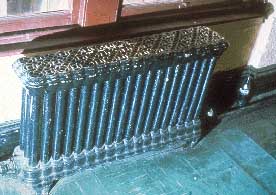
Historic
radiator preserved in rehabilitation. |
Mechanical,
lighting and plumbing systems improved significantly with the coming
of the Industrial Revolution. The 19th century interest in hygiene,
personal comfort, and the reduction of the spread of disease were
met with the development of central heating, piped water, piped
gas, and network of underground cast iron sewers.Vitreous tiles
in kitchens, baths and hospitals could be cleaned easily and regularly.
The mass production of cast iron radiators made central heating
affordable to many; some radiators were elaborate and included special
warming chambers for plates or linens. Ornamental grilles and registers
provided decorative covers for functional heaters in public spaces.
By the turn of the 20th century, it was common to have all these
modern amenities as an integral part of the building.
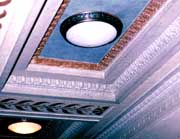
Electric lighting and decorative ceiling in an early 20th century office building. |
The
greatest impact of the 20th century on mechanical systems was the
use of electricity for interior lighting, forced air ventilation,
elevators for tall buildings, and electric heat.
The new age of technology brought an increasingly high level of
design and decorative art to the functional elements of mechanical,
electrical and plumbing systems.
The
visible decorative features of historic mechanical systems such
as grilles, lighting fixtures, and ornamental switchplates may contribute
to the overall historic character of the building and should thus
be retained and repaired, whenever possible. Their identification
needs to take place together with an evaluation of their physical
condition early in project planning. On the other hand, the functioning
parts of many older systems, such as compressors and their ductwork,
and wiring and pipes may often need to be upgraded or entirely replaced
in order to accommodate the new use and to meet code requirements.
|
|
Mechanical
Systems
|
....Identify,
retain, and preserve
|
 |
|
recommended.....
|

|
| |
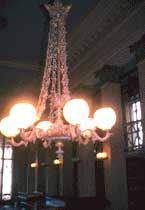
Ornate
gas lighting fixture that has been electrified. |
Identifying,
retaining, and preserving visible features of early mechanical systems
that are important in defining the overall historic character of
the building. This may include radiators, vents, fans, grilles, plumbing
fixtures, switchplates, and lights.
|
|
not
recommended.....
|

|
| |
Removing
or radically changing features of mechanical systems that are important
in defining the overall historic character of the building so that,
as a result, the character is diminished.
|
|
Mechanical
Systems
|
....Protect
and Maintain
|
 |
|
recommended.....
|

|
| |
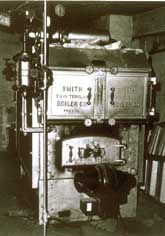
Boiler kept in good operational condition through ongoing maintenance. |
Protecting
and maintaining mechanical, plumbing, and electrical systems and
their features through cyclical cleaning and other appropriate measures.
Preventing
accelerated deterioration of mechanical systems by providing adequate
ventilation of attics, crawlspaces, and cellars so that moisture
problems are avoided.
Improving
the energy efficiency of existing mechanical systems to help reduce
the need for elaborate new equipment. Consideration should be given
to installing storm windows, insulating attic crawl space, or adding
awnings, if appropriate.
|
|
not
recommended.....
|

|
| |
Failing
to provide adequate protection of materials on a cyclical basis
so that deterioration of mechanical systems and their visible features
results.
Enclosing
mechanical systems in areas that are not adequately ventilated so
that deterioration of the systems results.
Installing
unnecessary air conditioning or climate control systems which can
add excessive moisture to the building. This additional moisture
can either condense inside, damaging interior surfaces, or pass
through interior walls to the exterior, potentially damaging adjacent
materials as it migrates.
|
|
Mechanical
Systems
|
....Repair
|
 |
|
recommended.....
|

|
| |
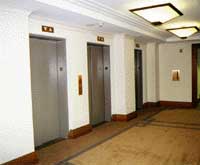
Rehabilitation
of elevators in a late 1920s commercial building. |
Repairing
mechanical systems by augmenting or upgrading system parts, such
as installing new pipes and ducts; rewiring; or adding new compressors
or boilers.
|
|
not
recommended.....
|

|
| |
Replacing
a mechanical system or its functional parts when it could be upgraded
and retained.
|
|
Mechanical
Systems
|
....Replace
|
 |
|
recommended.....
|

|
| |
Replacing
in kind--or with compatible substitute material--those visible features
of mechanical systems that are either extensively deteriorated or
are prototypes such as ceiling fans, switchplates, radiators, grilles,
or plumbing fixtures.
|
|
not
recommended.....
|

|
| |
Installing
a replacement feature that does not convey the same visual appearance.
|
| |
Alterations/Additions
for the New Use
The
following work is highlighted to indicate that it represents the
particularly complex technical or design aspects of rehabilitation
projects and should only be considered after the preservation concerns
listed above have been addressed.
|
|
recommended.....
|

|
| |
Installing
a completely new mechanical system if required for the new use so
that it causes the least alteration possible to the building's floor
plan, the exterior elevations, and the least damage to the historic
building material.
Providing
adequate structural support for new mechanical equipment.
Installing
the vertical runs of ducts, pipes, and cables in closets, service
rooms, and wall cavities. Installing
air conditioning units if required by the new use in such a manner
that historic features are not damaged or obscured and excessive
moisture is not generated that will accelerate deterioration of
historic materials. Installing
heating/air conditioning units in the window frames in such a manner
that the sash and frames are protected. Window installations should
be considered only when all other viable heating/cooling systems
would result in significant damage to historic materials.
|
|
not
recommended.....
|

|
| |
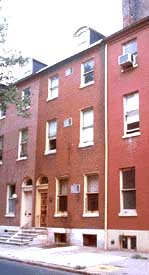
Historic building material destroyed by through-the-wall air-conditioners. |
Installing
a new mechanical system so that character-defining structural or
interior features are radically changed, damaged, or destroyed.
Failing
to consider the weight and design of new mechanical equipment so
that, as a result, historic structural members or finished surfaces
are weakened or cracked.
Installing
vertical runs of ducts, pipes, and cables in places where they will
obscure character-defining features.
Concealing
mechanical equipment in walls or ceilings in a manner that requires
the removal of historic building material.
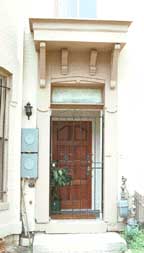
Inappropriate installation of new meters on primary elevation. |
Installing a
"dropped" acoustical ceiling to hide mechanical equipment when this
destroys the proportions of character-defining interior spaces.
Cutting
through features such as masonry walls in order to install air conditioning
units.
Radically
changing the appearance of the historic building or damaging or
destroying windows by installing heating/air conditioning units
in historic window frames.
|
|

